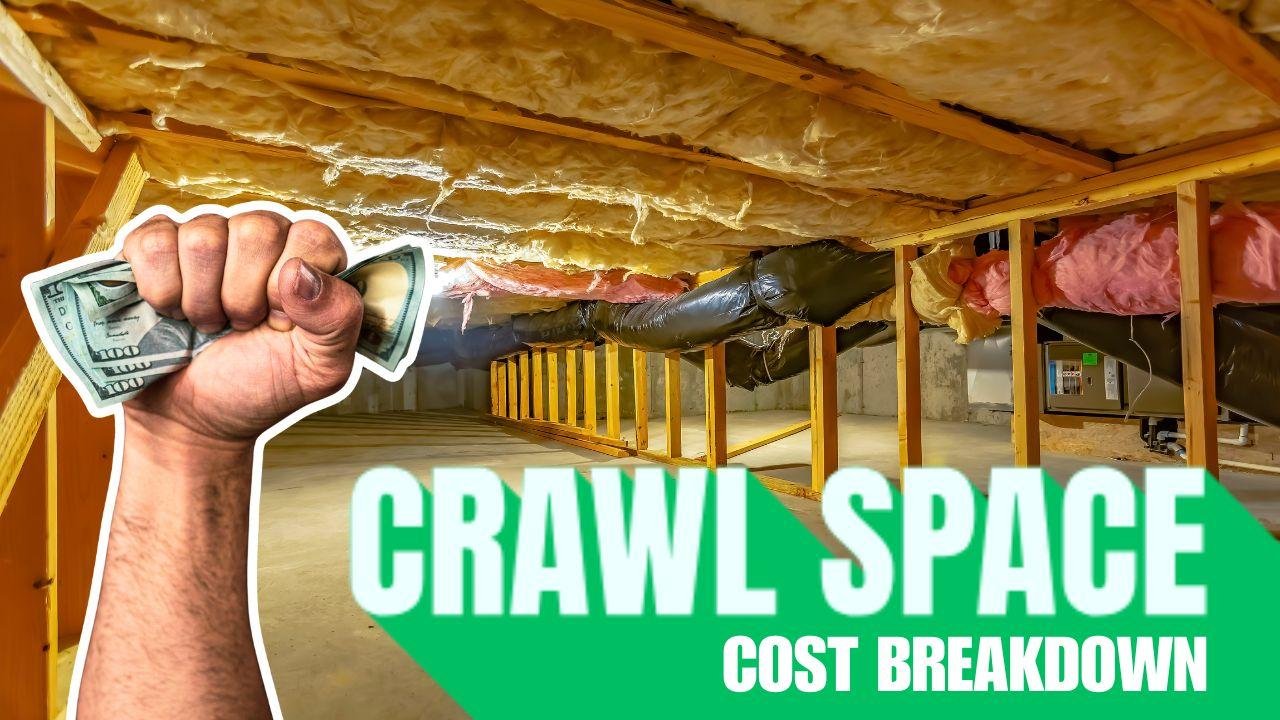-
Fil d’actualités
- EXPLORER
-
Blogs
-
Groupes
How Much Does Crawl Space Encapsulation Cost? A Complete Breakdown

Sarah noticed a musty smell every time she walked through her hallway. After months of wondering where it was coming from, she finally grabbed a flashlight and peered into her crawl space. What she found wasn't pretty: standing water, visible mold patches, and what looked like pest droppings scattered across the dirt floor.
If this scenario sounds familiar, you're not alone. Millions of homeowners deal with moisture, mold, and pest issues in their crawl spaces—problems that can affect your entire home's air quality and structural integrity.
Crawl space encapsulation offers a straightforward solution for maintaining a clean, dry, and energy-efficient home. This process involves sealing your crawl space with vapor barriers and other materials to create a controlled environment that keeps moisture, pests, and contaminants out.
This guide will walk you through everything you need to know about crawl space encapsulation costs. You'll learn how the process works, what factors influence pricing, whether DIY is worth considering, and how to find qualified contractors. Most importantly, you'll discover how this investment can save you money in the long run while improving your home's comfort and value.
What Is Crawl Space Encapsulation?
Crawl space encapsulation is the process of sealing your home's crawl space using vapor barriers, insulation, and other specialized materials to create a dry and controlled environment. Think of it as creating a protective shell around your crawl space that keeps unwanted moisture, air, and pests from entering.
The encapsulation process typically involves several key steps:
Vapor Barrier Installation: A heavy-duty plastic or polyethylene sheet is installed across the floor and up the walls of your crawl space. This barrier prevents ground moisture from entering your home.
Sealing and Insulation: All cracks, gaps, and openings are sealed using specialized foam or caulk. Insulation may be added to walls or between floor joists to improve energy efficiency.
Ventilation Control: Traditional crawl space vents are sealed, and a controlled ventilation system may be installed to manage air circulation.
Moisture Management: Dehumidifiers or drainage systems may be added to maintain proper humidity levels and handle any water that does enter the space.
This comprehensive approach creates a barrier between your living space and the outside environment, effectively controlling moisture levels and preventing the conditions that lead to mold growth, wood rot, and pest infestations.
Why Should You Consider Crawl Space Encapsulation?
Crawl space encapsulation offers several compelling benefits that make it a worthwhile investment for many homeowners:
Moisture Control and Structural Protection: Excess moisture is the enemy of your home's structural integrity. When moisture enters your crawl space, it can cause wooden floor joists and support beams to rot, leading to sagging floors and costly repairs. Encapsulation prevents this moisture from entering in the first place.
Improved Indoor Air Quality: Your crawl space air doesn't stay in the crawl space. Studies show that up to 50% of the air in your home comes from your crawl space due to the "stack effect"—warm air rising through your house. By sealing and controlling your crawl space environment, you prevent mold spores, allergens, and other contaminants from entering your living areas.
Enhanced Energy Efficiency: An encapsulated crawl space helps regulate temperature throughout your home. You'll experience fewer drafts, more consistent temperatures, and reduced strain on your HVAC system. Many homeowners see a 10-20% reduction in their heating and cooling costs after encapsulation.
Pest Prevention: Sealed crawl spaces make it much harder for insects, rodents, and other pests to enter your home. The moisture control also eliminates the damp conditions that attract many pests in the first place.
Increased Home Value: A properly encapsulated crawl space is an attractive feature for potential buyers. It demonstrates that you've taken proactive steps to protect the home's structural integrity and indoor environment.
Long-Term Savings: While encapsulation requires an upfront investment, it can save you significant money over time by preventing costly repairs, reducing energy bills, and extending the life of your HVAC system.
Factors That Affect Crawl Space Encapsulation Cost
Understanding what influences encapsulation costs helps you budget effectively and avoid surprises. Here are the key factors that affect pricing:
Size of Your Crawl Space
The square footage of your crawl space is the primary cost driver. Larger spaces require more materials and labor time, which increases the overall price. Most contractors price encapsulation projects per square foot, with costs typically ranging from $3 to $8 per square foot for basic encapsulation.
Current Condition of the Space
The existing state of your crawl space significantly impacts costs:
- Clean, dry spaces require minimal prep work and cost less to encapsulate
- Moisture damage may require mold remediation, wood replacement, or structural repairs before encapsulation can begin
- Pest infestations need to be addressed and cleaned up, adding to labor costs
- Debris removal from construction materials, old insulation, or accumulated junk increases project time and disposal fees
Geographic Location
Regional pricing differences can vary significantly:
- Urban areas typically have higher labor costs but more contractor competition
- Rural locations may have lower labor rates but limited contractor availability
- Climate considerations in humid regions may require additional moisture control measures
- Local building codes can affect material requirements and permitting costs
Type of Encapsulation Materials
Material quality and type affect both upfront costs and long-term performance:
- Basic vapor barriers (6-mil polyethylene) cost less but may not last as long
- Premium barriers (12-mil or reinforced materials) offer better durability and puncture resistance
- Insulation choices range from basic fiberglass to high-performance spray foam
- Drainage systems and sump pumps add significant costs but may be necessary for wet crawl spaces
Additional Services Required
Your project may need extra services that increase costs:
- Mold remediation can add $1,000-$5,000 depending on severity
- Structural repairs for damaged joists or supports vary widely in cost
- Drainage installation for water management can add $2,000-$10,000
- Electrical work for dehumidifiers or lighting increases the total investment
Typical Cost Breakdown
Understanding the cost components helps you evaluate quotes and make informed decisions about your encapsulation project.
Materials Costs
Vapor Barriers: The primary barrier material typically costs $0.50-$2.00 per square foot, depending on thickness and quality. A 1,500-square-foot crawl space might require $750-$3,000 in barrier materials.
Sealants and Adhesives: Professional-grade sealants for gaps and seams add $200-$500 to most projects.
Insulation: If included, insulation costs vary widely:
- Fiberglass batts: $1-$3 per square foot
- Rigid foam boards: $2-$4 per square foot
- Spray foam: $3-$7 per square foot
Drainage Materials: French drains, sump pumps, and related materials can add $1,000-$5,000 to your project.
Labor Costs
Labor typically represents 50-70% of your total encapsulation cost. Professional installation ranges from $2-$6 per square foot, depending on:
- Project complexity
- Local labor rates
- Contractor experience level
- Accessibility of your crawl space
Additional Services
Mold Remediation: $500-$3,000 for minor issues, $3,000-$10,000 for extensive problems
Structural Repairs: $1,000-$5,000 for minor repairs, potentially much more for major structural issues
Dehumidifier Installation: $800-$2,500 for commercial-grade units
Electrical Work: $300-$1,500 for lighting and electrical outlets
Total Project Cost Ranges
Based on these factors, here are typical cost ranges for different project sizes:
Small Crawl Space (500-800 sq ft): $1,500-$5,000
- Basic encapsulation with standard materials
- Minimal prep work required
- No additional moisture control systems
Medium Crawl Space (800-1,500 sq ft): $3,000-$8,000
- Standard encapsulation with quality materials
- Some prep work and minor repairs
- May include basic drainage or dehumidification
Large Crawl Space (1,500+ sq ft): $5,000-$15,000+
- Comprehensive encapsulation with premium materials
- Extensive prep work, repairs, or remediation
- Advanced moisture control systems
Premium Projects: $10,000-$25,000+
- Severe moisture or structural issues
- High-end materials and systems
- Extensive drainage and climate control
DIY vs. Professional Encapsulation
The decision between DIY and professional installation depends on your skills, time, and budget. Here's an honest assessment of both approaches:
DIY Encapsulation: Pros and Cons
Advantages of DIY:
- Cost savings: You can save 40-60% on labor costs
- Timeline control: Work at your own pace without scheduling contractors
- Learning experience: Gain hands-on knowledge about your home's systems
- Quality control: Ensure work meets your personal standards
Disadvantages of DIY:
- Physical demands: Crawl space work is uncomfortable and physically challenging
- Technical knowledge required: Proper sealing and moisture management require expertise
- Tool and equipment costs: You'll need specialized tools and safety equipment
- Time investment: Projects often take much longer than anticipated
- No warranty: You're responsible for fixing any problems that arise
- Safety risks: Exposure to mold, electrical hazards, and confined spaces
When DIY Makes Sense
Consider DIY encapsulation if:
- Your crawl space is in good condition with no moisture or mold issues
- You have construction experience and the necessary tools
- You're comfortable working in confined spaces
- You have plenty of time to complete the project properly
- Your local codes don't require professional installation
When to Hire Professionals
Choose professional installation if:
- You've discovered mold, standing water, or structural damage
- Your crawl space requires extensive prep work or repairs
- You lack the time, tools, or physical ability to complete the work
- Local codes require professional installation or permits
- You want warranty protection and guaranteed results
DIY Cost Estimates
If you choose the DIY route, budget for these material costs:
- Vapor barrier: $0.50-$2.00 per square foot
- Tape and sealants: $100-





